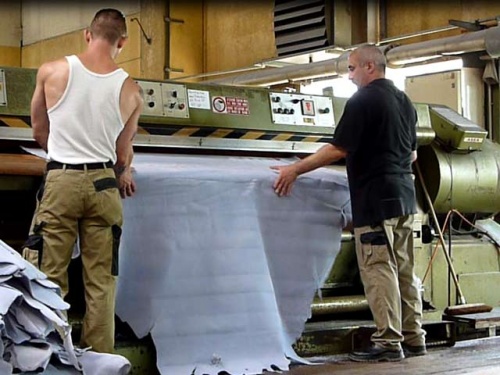Difference between revisions of "Shaving"
| Line 8: | Line 8: | ||
The shaved leather fibres are then pressed and undergo a waste treatment process e.g. incineration. In some cases, shaved leather fibres are also used to produce [[bonded leather]]. | The shaved leather fibres are then pressed and undergo a waste treatment process e.g. incineration. In some cases, shaved leather fibres are also used to produce [[bonded leather]]. | ||
| + | |||
| + | The accuracy of shaving is controlled by the moisture content of the leather, the set thickness per pass, the sharpening of the shaving knife, and the feed speed during entry into the shaving machine. An investigation revealed that the cutting speed of the shaving cylinder also has an impact on accuracy. Machines with a speed of 24.5m/s to 27.5m/s yielded significantly better results for tough and elastic leather fiber structures compared to machines with a speed of 16.5m/s to 18.5m/s. | ||
After shaving, the outer contour is trimmed if necessary if there are damaged areas. The trimming is done sparingly so as not to remove any usable area. | After shaving, the outer contour is trimmed if necessary if there are damaged areas. The trimming is done sparingly so as not to remove any usable area. | ||
Revision as of 16:32, 13 July 2023
Shaving leather
The leather has to reach the desired thickness in the tannery. To achieve this, the skin is first split on the splitting machine. Next a shaving machine, comprising knives arranged in a spiral formation, shaves the flesh side of the leather until the appropriate thickness is obtained. The fibres are cut to an even thickness. When shaving, the leather must contain residual moisture so that the shaving is even. The water content in each skin and across all skins must be the same in order to achieve equally good results.
The shaved leather fibres are then pressed and undergo a waste treatment process e.g. incineration. In some cases, shaved leather fibres are also used to produce bonded leather.
The accuracy of shaving is controlled by the moisture content of the leather, the set thickness per pass, the sharpening of the shaving knife, and the feed speed during entry into the shaving machine. An investigation revealed that the cutting speed of the shaving cylinder also has an impact on accuracy. Machines with a speed of 24.5m/s to 27.5m/s yielded significantly better results for tough and elastic leather fiber structures compared to machines with a speed of 16.5m/s to 18.5m/s.
After shaving, the outer contour is trimmed if necessary if there are damaged areas. The trimming is done sparingly so as not to remove any usable area.
Shaving. Checking the thickness.
Leather fibres are shaved.
Video about the leather production
The leather production in a modern tannery.
Additional information
- Thickness of leather
- Measures and weights
- Leather waste
- Bonded leather
- Artificial leather with leather fibres on the reverse
| Process steps in the leather production |
|---|
| storage - soaking - liming - fleshing - splitting - pickling - tanning - neutralising - withering - sorting - shaving - dyeing - fatliquoring - retanning - drying - finish - softening - final check |
| Tanning methods |
|---|
| Chrome tanning - Vegetable-tanned leather - Synthetic tanning - Tanning with fats and oils |











 a kotori web solution
a kotori web solution